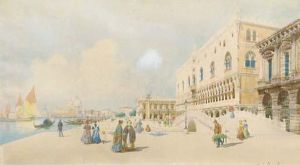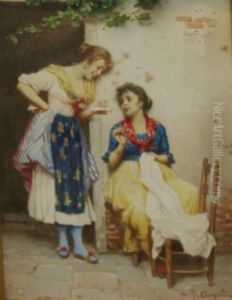D G Angiolini Paintings
Gasparo Angiolini, born Domenico Maria Gasparo Angiolini on February 9, 1731, in Florence, Italy, was a prominent figure in the development of ballet during the 18th century. His contributions to the art form were pivotal in the transition from the courtly dances of the Baroque era to the more expressive and dramatic ballets of the Romantic period. Angiolini was not only a skilled choreographer but also a theorist and director, whose works and ideas left a lasting impact on the world of dance.
Educated in the arts from a young age, Angiolini initially trained in music but soon developed a passion for dance. He embarked on a career that saw him travel across Europe, working in various capacities within the ballet companies of major cities. His talents eventually led him to the position of ballet master at the Imperial Theatres in Vienna, where he collaborated with Christoph Willibald Gluck, the famous composer. Together, they created the ballet 'Don Juan oder Der steinerne Gast' in 1761, which showcased Angiolini's innovative approach to choreography, integrating narrative, music, and dance in a way that was groundbreaking for its time.
Angiolini's philosophy of dance was articulated in his treatise 'Lettere a Sua Altezza Reale il Principe di Brunswick' (Letters to His Royal Highness the Prince of Brunswick), published in 1773. In this work, he argued for the expressive power of ballet, emphasizing the importance of dramatic truth and the integration of all theatrical elements. He believed that dance should not be merely decorative or entertaining but should convey genuine emotion and contribute to the storytelling of a performance. This approach laid the groundwork for the narrative ballets that would become central to the Romantic movement in dance.
Throughout his career, Angiolini's work was characterized by a commitment to this expressive potential of ballet. He staged numerous ballets across Europe, each reflecting his innovative use of movement to tell a story. Though his name may not be as widely recognized today as some of his contemporaries, Angiolini's influence on the development of ballet is undeniable. He helped to transform ballet from a courtly diversion into a serious dramatic art form, paving the way for future generations of choreographers and dancers.
Angiolini's later years were spent away from the limelight, as he retired to Milan, where he passed away on January 1, 1803. Despite his departure from the stage, his legacy lived on through his writings and the memories of those who had seen his works. Today, Angiolini is remembered as a visionary who played a crucial role in the evolution of ballet, advocating for an art form that could move, inspire, and tell stories with grace and power.

